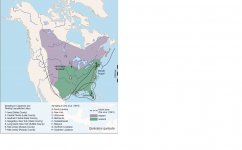albertonykus
Well-known member
Capainolo, P., U. Perktaş, and M.D.E. Fellowes (2020)
Late Quaternary range dynamics in the Common Grackle Quiscalus quiscula
Ardea 108: 95-104
doi: 10.5253/arde.v108i1.a8
https://bioone.org/journals/ardea/volume-108/issue-1/arde.v108i1.a8/Late-Quaternary-Range-Dynamics-in-the-Common-Grackle-Quiscalus-quiscula/10.5253/arde.v108i1.a8.full
Climate variability is one of the most important forces affecting the distributional range dynamics of species and consequentially plays a significant role in shaping biogeographic patterns. This study aims to infer the role of climate in the recent evolutionary history of the Common Grackle Quiscalus quiscula. Studies of other migratory North American birds have shown that their populations were isolated in two or three refugia in southern North America during the Last Glacial Maximum (LGM). In contrast, preliminary genetic work suggests that Common Grackles may have occupied a single refugium during that time. They subsequently became widespread and northern populations evolved highly migratory behaviour. We used an ecological niche modelling approach that involved the use of three general climate models for the past (the LGM, approximately 22,000 years before present) and for present environmental conditions to identify climatically stable areas. Extrapolations to the past showed contraction to a large continuous refugium located in the southern part of North America, and projection to the present showed expansion that covers much of eastern and middle North America. The most important bioclimatic variable for model predictions was annual mean temperature, which explained 74% of the variation in the model. Results suggest that the Common Grackle has expanded its distributional range by more than 300% after the LGM.
Late Quaternary range dynamics in the Common Grackle Quiscalus quiscula
Ardea 108: 95-104
doi: 10.5253/arde.v108i1.a8
https://bioone.org/journals/ardea/volume-108/issue-1/arde.v108i1.a8/Late-Quaternary-Range-Dynamics-in-the-Common-Grackle-Quiscalus-quiscula/10.5253/arde.v108i1.a8.full
Climate variability is one of the most important forces affecting the distributional range dynamics of species and consequentially plays a significant role in shaping biogeographic patterns. This study aims to infer the role of climate in the recent evolutionary history of the Common Grackle Quiscalus quiscula. Studies of other migratory North American birds have shown that their populations were isolated in two or three refugia in southern North America during the Last Glacial Maximum (LGM). In contrast, preliminary genetic work suggests that Common Grackles may have occupied a single refugium during that time. They subsequently became widespread and northern populations evolved highly migratory behaviour. We used an ecological niche modelling approach that involved the use of three general climate models for the past (the LGM, approximately 22,000 years before present) and for present environmental conditions to identify climatically stable areas. Extrapolations to the past showed contraction to a large continuous refugium located in the southern part of North America, and projection to the present showed expansion that covers much of eastern and middle North America. The most important bioclimatic variable for model predictions was annual mean temperature, which explained 74% of the variation in the model. Results suggest that the Common Grackle has expanded its distributional range by more than 300% after the LGM.





